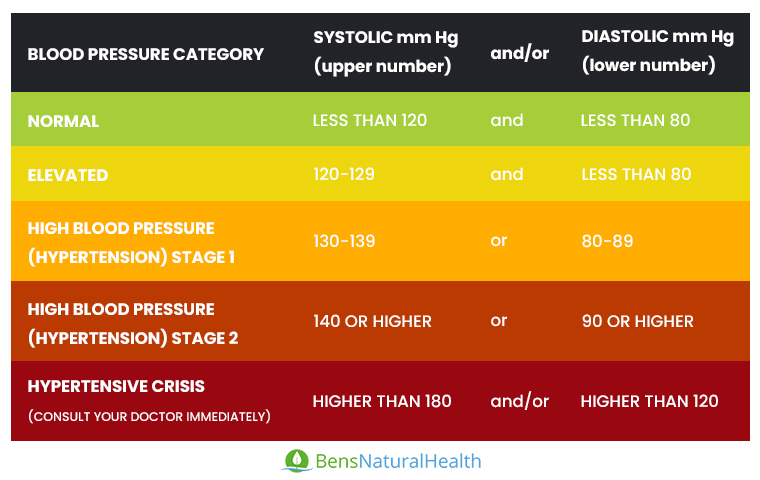Nearly half of all adult Americans have high blood pressure, and only a quarter of people with diagnosed high blood pressure have it under control.
Managing your blood pressure is one of the most important things you can do to help keep your heart healthy.
Fortunately, there are natural ways to keep your blood pressure in check, such as following a high blood pressure diet.
What is high blood pressure?
High blood pressure medically known as hypertension, is when blood pressure rises to unhealthy levels. As a result, the heart has to work harder to pump blood around the body, which can result in several serious complications, including an increased risk of a heart attack and stroke.
Your blood pressure is measured using a blood pressure cuff and is reported with a top and bottom number in milligrams of mercury (mm Hg).
The top number is your systolic blood pressure, which measures the pressure in your arteries when your heart beats. The bottom number is the diastolic blood pressure which measures the pressure in your arteries between heartbeats.
Normal blood pressure levels are less than 120 for the systolic blood pressure and less than 80 for the diastolic blood pressure. The classifications for high blood pressure can get confusing, so below is a chart to make it a little easier.

Having high blood pressure over time can cause your arteries to become stiff, which reduces blood flow and can lead to heart disease.
Other consequences of long-term high blood pressure include:
- Heart attack or stroke
- Aneurysm
- Heart failure
- Kidney problems
- Vision problems and/or vision loss from high pressure in your eyes
- Metabolic syndrome
- Trouble with memory or understanding
- Dementia
What’s the link between diet and high blood pressure?
Your diet plays a role in your blood pressure health. One of the biggest and most well-known
between diet and blood pressure is sodium.
Sodium is present in table salt as sodium chloride, but it’s also in additives and preservatives in processed and ready-to-eat foods. Any ingredient with “sodium” in it counts as sodium, such as monosodium glutamate, sodium citrate, sodium alginate, and sodium phosphate.
Eating excess sodium causes your body to retain fluid to try to balance out sodium levels in your body. When you retain more fluids, it takes more work for your heart to pump blood throughout your body, which raises your blood pressure.
Sodium intake is linked with both high blood pressure and increased cardiovascular disease (CVD) risk.
A diet high in added sugar and low in important nutrients like magnesium and potassium is also associated with high blood pressure.
Diets high in added sugar can also provide excess calories, which may lead to excess weight gain. Being at a higher body weight can make it harder to control your blood pressure.
Plant-based diets like a vegetarian diet are usually higher in nutrients and lower in sodium, which is one of the reasons they are linked with lower blood pressure.
7 foods to eat if you have high blood pressure
Your diet plays a major role in your blood pressure readings. A Mediterranean diet and DASH (Dietary Approaches to Stop Hypertension) diets are both excellent for heart health.
These diets are low in added sodium, added sugar, and saturated fat while being rich in beneficial vitamins, minerals, and other nutrients that can keep your heart healthy.
Here are several foods to include in a high blood pressure diet:
Bananas
Bananas are a great, convenient, and budget-friendly source of potassium. Potassium helps relax your blood vessels, which can reduce high blood pressure.
According to a study on over 4,600 adult men and women, banana consumption was inversely related to high diastolic blood pressure in some people.
One medium banana provides a little over 400 milligrams of potassium, which is a little over 10% of the recommended daily amount, which ranges from 2,600-to 3,400 milligrams per day for adults.

Fish
Fatty fish like salmon are rich in omega-3 fatty acids, which are considered heart-healthy and can help reduce inflammation. Lean, white meat fish like tilapia is low in saturated fat and is also considered a heart-healthy protein choice.
According to a study, eating salmon significantly reduced blood pressure and cholesterol levels compared to not eating fish.
Nuts and seeds
Nuts and seeds are a great source of magnesium, a mineral important for muscle relaxation and healthy blood pressure levels.
A review of 21 randomized controlled trials concluded that eating nuts led to a significant reduction in blood pressure in people without type 2 diabetes.

Leafy green vegetables
Leafy green vegetables like spinach, kale, collard greens, and Swiss chard contain natural nitrates, which are then converted to nitric oxide in your body. Nitric oxide acts as a vasodilator, helping to widen your blood vessels and promote healthy blood pressure levels.
Lentils
Legumes such as beans and lentils are a great source of plant-based protein and iron. Lentils are rich in fiber, which may help reduce both systolic and diastolic blood pressure.
Whole grains
Choose whole grains instead of refined grains on a high blood pressure diet. Not only are whole grains more nutrient-dense and filling, but studies show they may help lower blood pressure levels thanks to their nutrient and fiber content.
All fruits and vegetables
The DASH diet emphasizes a healthy diet rich in plant-based foods like fruits and vegetables, whole grains, and heart-healthy protein.
While certain fruits and vegetables are especially beneficial thanks to their standout vitamin and nutrient content, all fruits and vegetables are welcome in a high blood pressure diet.

Foods to avoid if you have high blood pressure
Excess sodium
Sodium is often found in processed and convenience foods like fast food, frozen entrees, canned soups, and deli meats.
Other sources of sodium might not be as obvious, but they can add up quickly if you eat several servings of them per day, such as bread.
Fast food is high in sodium since it’s an easy way to add flavor to foods. If you do eat fast food or processed food, try to watch your portion sizes and balance the higher-sodium foods with plenty of whole, less processed foods.
According to the Centers for Disease Control, 40% of the sodium in the typical Western diet comes from these ten foods:
- Bread and rolls
- Pizza
- Sandwiches
- Cold cuts and cured meats
- Soups
- Burritos and tacos
- Savory snacks (pretzels, jerky, chips, etc.)
- Chicken
- Cheese
- Eggs and Omelets
It’s recommended to keep your sodium intake below 2,300 milligrams per day. However, the average American consumes 3,400 milligrams of sodium per day.
Check the Nutrition Facts label and try to avoid foods with greater than 20% of the daily value of sodium per serving since these can add up quickly and put you past the 2,300 milligram daily sodium target.

Added sugar
As mentioned earlier, diets high in added sugar can contribute to high blood pressure.
Sugary drinks are the leading contributor of added sugar in a typical Western diet. Drinks like soda, sweetened teas, sugary coffee drinks, energy drinks, and more are high in added sugar.
Drinking sugary drinks regularly can cause weight gain and inflammation and lead to high blood pressure. Chronic inflammation can cause hardening of your arteries, which can cause high blood pressure.
Added sugar isn’t always easy to spot in foods. Sugar is added to foods that might otherwise seem healthy, like yogurt, dried fruit, some nutrition bars, and granola.
Many processed foods contain added sugar. Check the nutrition label to see if some of your favorite foods have hidden added sugar.
Instead of added sugar, eat foods with natural sugar like fruit. Fruit is rich in potassium, which helps relax your blood vessels and promotes healthy blood pressure levels.
Conclusion
To help keep your blood pressure in check, eat a healthy high blood pressure diet rich in whole plant-based foods as well as heart-healthy protein. Try to avoid processed foods with added sodium and sugar, which can worsen high blood pressure.
Explore More






